
The Mustang GT Performance Edition
Ford’s new Mustang Mach-E deftly checks all the boxes for buyers looking for a modest-sized crossover with solid driving performance, at least 300 miles of range in some configurations, and good efficiency at a reasonable price. It is the first electric Mustang since the iconic name was first introduced in the 1965 model year.
See also: Mustang Mach-E powertrain: up close and personal
It’s clear that Ford has closely studied Tesla’s playbook and designed a vehicle that closely matches many design elements of the Model Y which is also planned for delivery in the second half of 2020 at similar price points. For example, the Mach-E will be Ford’s first vehicle with downloadable software updates that apply not just to the infotainment computer but to all aspects of the car. Like a phone or laptop, features may evolve and improve over time. Ford plans to add hands-free steering assistance.
Pricing begins with the Select with a starting MSRP of $43,895 not including destination fee or various available tax credits and rebates. The Select has a 230-mile driving range and rear-wheel drive. A California RT 1 starts at $52,400 with an extended range battery expected to be EPA-rated for at least 300 miles. Ford vehicles still quality for the full $7,500 federal tax credit so those prices could effectively fall to $36,395 and $44,900 respectively for those who can take the full credit. Some states, like California, offer additional rebates and subsidies. See Ford’s website for details because pricing varies considerably across the different trims. These prices are roughly competitive with Tesla’s Model Y.
One key difference from Tesla, with advantages and sometimes perceived disadvantages, is that Ford will have some 2,100 EV-certified dealers across the United States with a total of more than 3,500 EV-trained service technicians. The remaining 1,000 or so dealers can also handle some non-EV related vehicle issues as well.
Immediately following today’s live-streamed reveal the company will begin taking reservations at Ford.com for the Mustang Mach-E online at 6:30pm Pacific. Placing a $500 refundable deposit allows a potential customer to configure a car and establish their place in line for a limited edition version of the car but it is not a final order or vehicle purchase.
Design
The new electric Mustang most closely resembles the Jaguar I-PACE and forthcoming Tesla Model Y EVs in its overall exterior dimensions and shape. The Mach-E carries over the distinctive Mustang tri-bar tail lights that animate when used as a turn signal. It also signals it’s heritage with a solid wide stance and scooped side door panels.
Ford originally planned to produce what they self-described as a “compliance car” by adapting an existing design from a vehicle sold it Europe and doing the minimal work to convert it to an EV. Company officials said they completely rebooted the project in the summer of 2017 as they realized they would need an all-out effort to create a competitive product.
The result looks impressive. The media were given a quick ride around some public and private roads at the Hawthorne Airport near Los Angeles in prototype cars — a location that just happens to be adjacent to Tesla’s design studio and SpaceX headquarters (whose board chairman is Tesla CEO Elon Musk). The Mach-E accelerated briskly and dodged a series of traffic cones at speed with little roll. A sophisticated rear suspension dampened the drainage dip running down the middle along the line of cones.
One unique feature is the doors handles, or rather the lack thereof. In place of normal door handles that you grab to unlatch and pull open the door there is a small round button on the door pillar above both the front and rear doors. Push the button, and the door pops open several inches on its own where you can grab the edge and pull it the rest of the way. For the front doors only, there is a small aerodynamic “pinkie finger” that can be used to pull the door open once it has been unlatched. A Ford designer said it was mostly there to guide peoples own fingers away from the door gap between the front and rear doors to avoid any pinching mishaps. The result is a visually interesting appearance but it remains to be seen how practical it will be.
The car supports using a Bluetooth-enabled phone in place of using a traditional key fob — a feature pioneered in Tesla’s Model 3. If your phone isn’t available, you can use Ford’s long-standing digital keypad on the driver-side door panel to open the door.
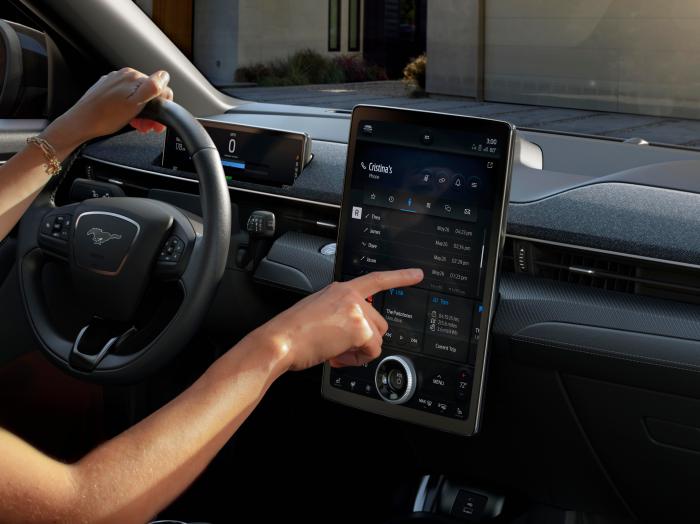
Inside, the large 15.5 inch vertically-mounted center display immediately calls to mind the 17 inch display in the Tesla Model S. Ford’s version has a dial mounted directly on the lower part of the screen that can be used for audio volume control today and perhaps other things in the future. Turning the dial causes a capacitive change which the screen’s multi-touch sensor picks up much like it does for human fingers but it can be instinctively used without the driver having to look at the screen to wipe an on-screen control. As part of a new trend, the Mach-E will support wireless CarPlay and Android Auto over WiFi. Until now, very few carmakers other than BMW have implemented it.
The cabin climate system uses resistive electrical (PTC) heaters like Tesla does rather than the more efficient heat pump (reverse AC) system that a few other car makers have adopted. Rear seat vents at the back side of the center console help keep would-be backseat drivers comfortable.
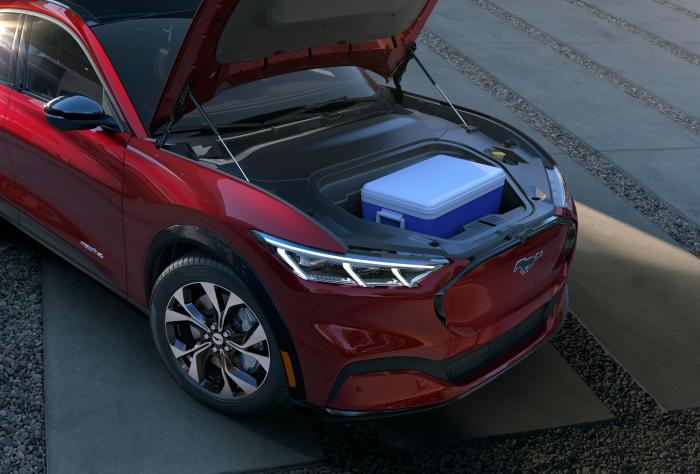
Passengers have lots of headroom in both front and rear and legroom is good all around as well. The liftback rear storage area provides 29 cubic feet with the rear seats up and 59.6 cubic feet with the seats lowered. Like some other EVs, a front trunk or “frunk” has a very usable 4.8 cubic feet. Ford’s frunk also features a drain so it can be packed with ice to keep drinks cold for frunk parties before the ballgame.
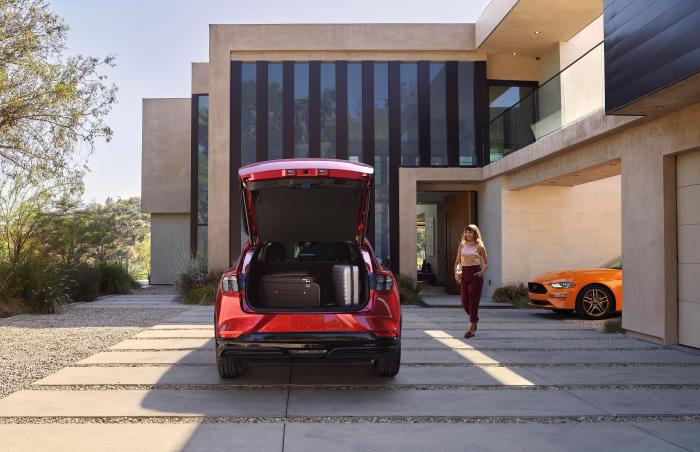
All versions of the Mach-E except for the entry-level Select feature a glass roof with an embedded layer of anti-UV protection.
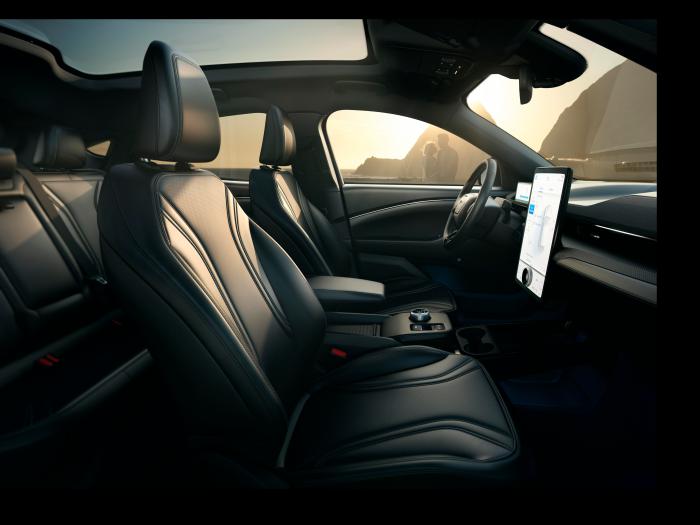
Driving Modes
The car has three pre-packaged driving modes called Whisper, Engage, and Unbridled that influence the steering, accelerator pedal mapping, display visuals, and ambient sound.
Whisper mode is for quiet and graceful driving with easier steering and subtle regenerative braking that lets you glide as you lift your foot off of the accelerator.
Engage mode tightens up the steering a bit, makes the go pedal more responsive, and blends in optional synthetic sounds reminiscent of the racing scenes from the movie Blade Runner.
Unbridled driving is fully-engaged and maxes out all of the above. Copper-toned ambient cabin lighting can be seen inside the car at night along with copper graphics in the driver’s display.
In addition to the three driving modes, shifting to the ‘L’ drive setting in any of them will bump up the default regenerative braking to assist during long downhill segments.
Electric Propulsion
Ford has a lot of practical experience designing and building its own electric drive motors since it began selling gasoline hybrid SUVs with the 2005 Ford Escape. The custom-designed motors in the Mach-E are direct descendants that follow the familiar permanent magnet synchronous AC pattern.
The rear motor is the largest and is responsible for doing most of the pushing when a front motor is also installed to provide all-wheel drive. The front motor adds-in when full power is needed and is also used for regenerative braking when the deceleration force naturally dives toward the front when coming to a stop.
With only RWD, Ford estimates the extended range battery will allow for more than 300 miles of range using the EPA methodology (final EPA ratings won’t be released until next year). Adding AWD drops that range down to 270 miles. With a standard range pack, RWD gets you 230 while adding AWD drops the range to 210 miles.
Power and torque output depend on the battery size and RWD vs AWD configuration. With the standard range pack, power can reach a peak of 255 HP (190 kW). With an extended range pack, RWD gets you 282 HP (210 kW) but you will need AWD to lay down a full 332 HP (248 kW). Regardless of battery version, RWD can deliver a peak of 306 pound feet of torque while AWD can twist with a force of up to 417 pound feet.
On those earlier trims the AWD front motor, if present, is smaller than the rear motor but on the GT Performance Edition the larger motor is used for both front and rear. This bumps up the raw power to a peak of 459 HP (342 kW) along with 612 pound feet of peak torque. That can launch the Mach-E GT to 60 mph in under four seconds (Ford says mid-3 seconds). The GT also features a magnetic suspension, 20-inch wheels and a unique patterned grille. To enable all of this power, the driving range ends up reduced to 235 miles.
The non-GT cars have to settle for launch times ranging from mid-five to mid-six seconds which is still very respectable.
Ford hasn’t provided MPGe driving efficiency numbers yet but based upon back-of-the-envelope calculations the long range battery with RWD is probably around 100 MPGe with AWD dropping that down to around 90 MPGe. The standard range pack is probably a little better due to reduced pack weight. This would be quite a bit better than the Jaguar I-PACE and Audi e-tron which get around 75 MPGe overall but Tesla’s Model Y is probably going to be even that much better when they release their EPA estimates in the future.
Battery pack and charging
The Mach-E comes with either a standard or an optional extended range pack. The pack is a very typical “skateboard” format which rides underneath the floor between the front and rear wheels.
The battery cells are made by LG Chem in their recently opened factory in Wroclaw, Poland which also supplies the cells used in the Jaguar I-PACE and Audi e-tron. Although cells are often tweaked and customized for each customer, all three cars use a cell of the same approximate size and appearance. The full car itself will be assembled at Ford’s factory in Cuautitlan, Mexico.

Dr. Danson Joseph, the leader of the I-PACE battery group, holds one of the car’s LG cells. The cells used in the Mach-E have a roughly similar appearance.
During a briefing on the car’s design, engineering managers answered questions about the long-range version of the battery pack which was on display. Unfortunately, photographs were not allowed.
The long-range version contains 376 cells in 94 cell groups containing 4 cells in parallel for a storage capacity of 98.8 kWh. The standard version contains 288 cells in 96 cell groups containing 3 cells in parallel which has a capacity of 75.7 kWh. The actual usable capacity is a bit smaller in order to preserve battery longevity although Ford won’t say how much is held in reserve.
Using about 96 cell groups in series is a typical configuration among commercial EVs today. With a nominal voltage of about 3.6V for each cell group it results in a nominal pack voltage at or just below 350V. This is unlike the I-PACE and Audi e-tron which both use 432 cells configured into cell groups with 4 cells each and thus a total of 108 cell groups.
This difference carries interesting implications. Ford has a pack with fewer cells but a larger energy capacity. If you crunch the numbers, the I-PACE cells contain about 58 Ah of capacity, the e-tron around 60 Ah, and the Mach-E around 73 Ah. Since the cells superficially appear to be around the same form factor this could imply that the cells being used by Ford have a higher energy density based on a new generation of cell chemistry and design. Or they could just have slightly larger physical dimensions. Or both.
When asked, company officials confirmed that the cells use an NMC (Nickel, Manganese, Cobalt) cathode chemistry but declined to say if they use the latest “811” element ratio that reduces more expensive Cobalt to 10 percent versus the more common previous ratio of 20 percent. They also declined to say if the anode uses any Silicon mixed in with the graphite which is a trick that Tesla uses in their Nickel, Cobalt, and Aluminum (NCA-based) cells made by Panasonic.
The pack itself is constructed into multiple modular collections of cell frames. The frames have an appearance somewhat similar to the cell frames used by Hyundai (pictured below.) The extended long-range pack differs by having a second modular layer of cells above the main skateboard in a position that uses space under the rear seats.
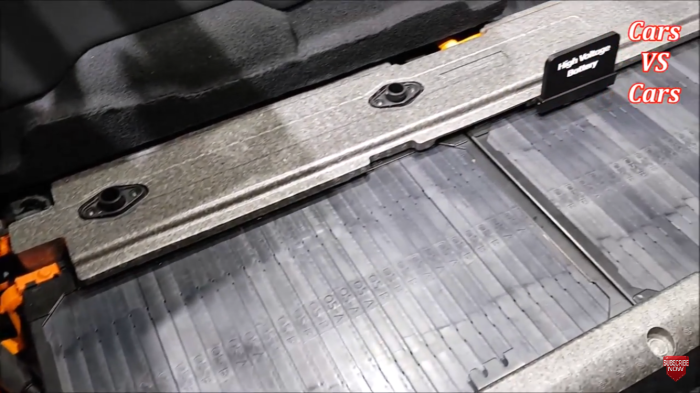
The Mach-E cells are held by black frames roughly similar in appearance to the ones used by Hyundai in the Kona Electric (dozens of which are pictured here in this still image taken from a Cars vs Cars video on YouTube). Although the cell frames look similar, they are grouped and laid out differently.
This layout is different from the I-PACE and e-tron both of which package their cells 12 at a time into 36 aluminum “shoeboxes”. However, all of these cars as well as the Chevrolet Bolt EV use an active liquid coolant plate running under the cells. Coolant is actually a misnomer because the water-based glycol mixture (similar to what is used to cool gasoline engines) can either cool the cells by tapping into the car’s air conditioning system or heat the cells in the winter by presumably using a dedicated electric heating element.
Ford did not go into further details of its battery temperature management system so it’s unclear if they use any techniques to leverage the waste heat from the motor and motor inverter to help warm the battery as Tesla, Hyundai, Rivian, and some other carmaker do. The pack has been tested down to -40 degrees.
See also: Exclusive: details on Hyundai’s new battery thermal management design
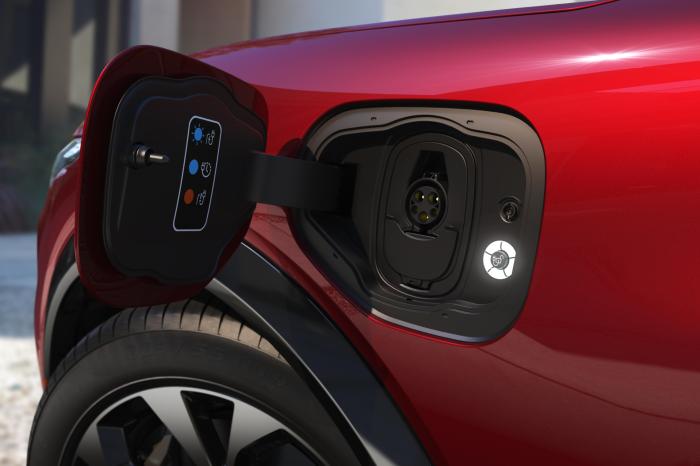
The small round segmented lighted circle indicates charge settings and progress. Inside the circle, a button can be used to control locking of the charge plug to the car.
The Mach-E has good charging capability. So-called Level 2 or 240V AC charging can handle up to 48A and fast DC charging will take in a peak of up to 150 kW on the large pack. Achieving that power may actually require a charger labeled as being capable of handing 350 kW. Why? Because chargers labeled as handling 150 kW are usually limited to 350A of output current and with the Mach-E battery’s voltage design range it will likely peak at less than 130 kW on a 350A charger. Fortunately, Electrify America almost always has at least two 350 kW (500A) capable chargers at its highway locations. The standard battery pack has a peak charging rate of 115 kW, so no problem there.
According to Ford, this translates into an “estimated average” of 47 miles added during a 10 minute fast charge on a suitable charger for the extended battery using RWD.
Charging from 10 to 80 percent can take as little as 38 minutes while adding around 160 miles of range (out of a full 230) on the standard range version of the pack using RWD. Although Ford didn’t say so, that’s an average charge power near 80kW on that 70 percent refill of the likely usable part of the 75.7 kWh standard range pack. These are good rates although they can’t compete with Tesla’s Model 3 charging speeds. The average power on an extended range pack would be somewhat higher but Ford says it would take 45 minutes to reach 80 percent full on a “150 kW charger”.
Correction: the article earlier assumed that the 38-minute 10 to 80 percent charge time given by Ford was for an extended range battery.
Ford supplies each Mach-E with a portable AC charge cord capable of supporting 32A charging on a 40A home 240V circuit. It can also charge using a regular 120V outlet by trivially swapping charge plug “pigtails”. An optional network-connected charging station can be purchased and installed which will support the full 48A AC charge rate on a dedicated 60A circuit.

Ford has established a “FordPass” arrangement with multiple charging providers including Electrify America, EVgo and ChargePoint among others. Rather than needing separate accounts with each provider, a customer can manage and pay for all charging with one account at over 12,500 charging stations with more then 35,000 charge plugs (240V and fast DC sites combined).
The Mach-E will be among the first EVs to integrate support for “Plug and Charge” which allows customers at some charging locations to just plug the car into the charger and walk away without having to use a credit or RFID card or a phone app to authenticate and authorize payment. This is very similar to how Tesla cars work at a Supercharger station although the technical implementation is different. Electrify America is expected to roll out the charger side of this feature next year.
See also: Electrify America working with Hubject to add “Plug & Charge” support
Charging is deeply integrated into the navigation system so the car can automatically suggest when and where to stop when needed. Online status for many charging sites is available and displayed on the center navigation screen using the car’s 4G cellular network telematics. This allows Ford to potentially do things like pre-warm the battery before arriving at a DC charging site.
Note: Ford paid hotel and food expenses during a 3 day media briefing in Los Angeles
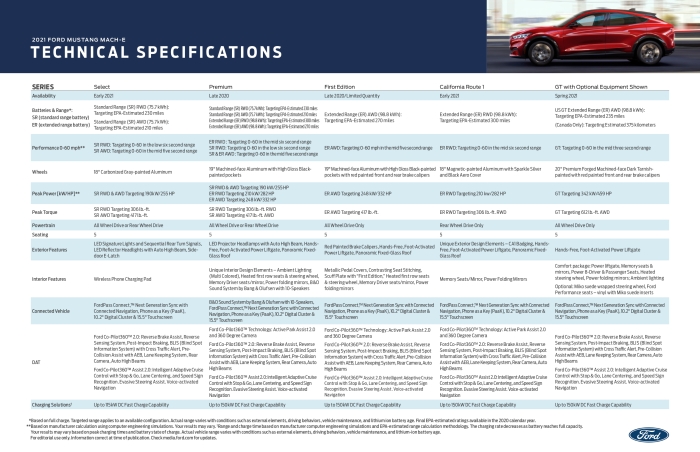

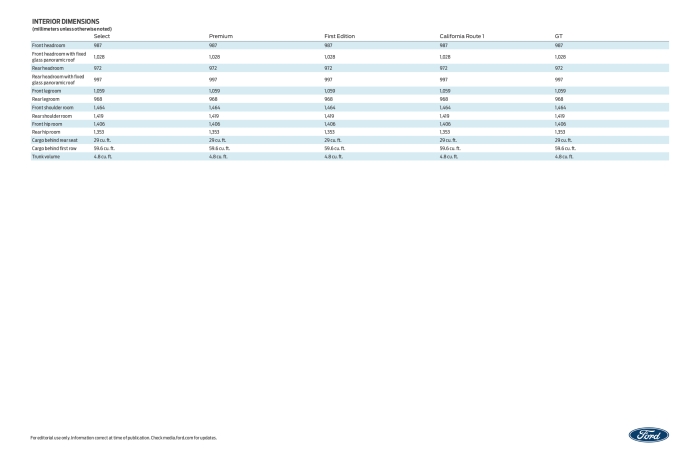
Categories: General
210 miles (10-80% for 300 mile ER RWD) in 38 minutes is 5.5 miles per minute.
47 miles in 10 minutes is 4.7 miles per minute. Ford expresses this as a peak rate. It’s not clear if this is conservative in some way – for example, refers to a lower range vehicle, or if the 10-80% number is wrong.
LikeLiked by 1 person
Thanks for asking. I checked and it turns out that I made a bad assumption. The article has been corrected.
The 10 to 80 percent charge claim was actually based on a standard range battery.
The claim for 47 miles in 10 minutes, however, was based on an extended range pack with RWD. It does seem
conservative and Ford says it was calculated as an “estimated average”, whatever that means.
These are all guideposts. We won’t actually know for sure until real customers show up at real charging stations.
LikeLike
Hej
Jeg vil gerne vide hvilken oplademetode
der er mest skånsomt for batterier om det er hjemmeladning på feks. 11kw eller det er bedre med hurtiglader ude i byen ?
På forhånd tak
Mvh
LikeLike
Opladning derhjemme (11 kW eller langsommere) er mere skånsom for batteriet end hurtig opladning. Det er dog ikke den store forskel. En vigtigere årsag til batterinedbrydning kan være at have en fuldt opladet (100%) bil, der ikke er kørt i flere dage.
LikeLike